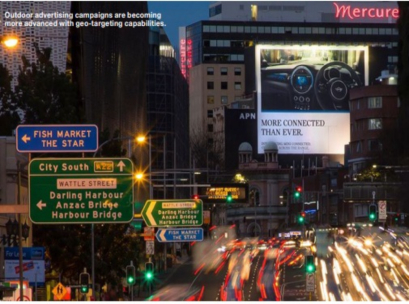 When online homewares retailer Hunting for George launched a temporary pop-up located in Highpoint Shopping Centre in suburban Melbourne at the end of last year – its first-ever physical storefront – it primarily wanted to give loyal customers a place to see its products in the flesh.
When online homewares retailer Hunting for George launched a temporary pop-up located in Highpoint Shopping Centre in suburban Melbourne at the end of last year – its first-ever physical storefront – it primarily wanted to give loyal customers a place to see its products in the flesh.
However, the retailer was also out to increase brand awareness in the area and, despite having primarily focused on digital advertising
channels in the past, it opted to rent a large hoarding for the fourweek period leading up to the opening of the pop-up.
Highpoint reportedly greeted over one million visitors during the time that Hunting for George’s pop-up was open, and the company says it saw a spike in traffic and sales coming from the Melbourne area after the hoarding went up and a 10 per cent conversion of instore customers into repeat online customers.
“When we went into Highpoint we saw a huge increase in brand awareness,” Hunting for George sales and marketing manager Jonno Rodd tells IRW.
The end results convinced Rodd of the strategic power of good, focused outdoor advertising. “In that case when you are casting a wide net, and spending a lot to capture a lot of eyes, then outdoor is going to be a great, cost effective medium,” Rodd says.
However, in a world where digital advertising is fairly cheap, effective and can be extremely focused, how can outdoor advertising compete?
Making use of mobile APN Outdoor’s general manager of marketing Charlotte Valente believes that part of an outdoor advertisement’s strength is in its ability to entertain its audience.
“The medium itself is the entertainment,” Valente tells IRW. “If you think about when you’re scrolling through your Facebook feeds or your Instafeeds, or you’re searching something on Google, you don’t want to necessarily be interrupted by ads, or you tend to be quite passive towards ads that are served to you.
“[However] if you think of someone sitting in their car driving to work … being able to distract from what is otherwise a mundane
commute is the power of outdoor.”
Valente notes that while it has traditionally been difficult to target and measure the impact of outdoor ad campaigns, the sector has evolved to take advantage of digital technology in recent years, enabling proactive and contextual advertising in a static, fixed location.
“Where [outdoor advertising] is innovating is in its ability to be used in conjunction with mobile. Every single consumer now has a smartphone and, obviously, geo-targeting is a massive advantage in terms of reaching someone in the right place,” Valente says. For example, it can be valuable to deliver a message around a quick service restaurant’s breakfast, lunch or dinner offering depending on the time of day, or display an ad for a business like Dan Murphy’s in the afternoon, rather than the morning.
“That advertising can be extremely effective because people on their way home from work do drop in to Dan Murphy’s and get alcohol, they think about buying alcohol on their way home, or if they’re not thinking about it they will be after they see the ad,” Citrus co-founder and chief executive Brad Moran tells IRW.
Citrus is a digital advertising platform that allows online marketplaces and retailers to monetise their product listings by selling the top spots to the highest bidder based on the relevance of the bidder’s product for individual consumers.
Moran notes that, for certain categories, outdoor advertising is sometimes more effective than its digital counterpart. “I think for fast-moving consumer goods, things like liquor, it makes total sense to advertise to people [outdoors] because it can evoke an immediate reaction,” Moran says.
For cars, electronics and other categories that don’t necessarily involve impulse purchases, Moran says outdoor advertising is more about broadcasting brand consistency and creating awareness.
“People aren’t just thinking about buying televisions and laptops all the time, so the outdoor campaigns for retailers that are in that
space need to be about the value proposition of the brand,” Moran says.
“The effective retailers will focus on their messaging and the value offering… they need a broad stroke in all channels. Every customer touch point is important, but the brand’s messaging needs to be consistent.”
Apple does this style of marketing well. Its products are not impulse buys, since new phones tend to be released every two to three years, while a customer may go five years or more between laptop purchases. The main driver of Apple’s advertising is its brand, rather than its product.
The best of outdoor This brings us back to the perceived difficulty of tracking the impact of outdoor advertising campaigns on incremental sales. How does a business know whether the customer who just purchased an item came in as a result of the billboard down the street, or because they were planning the purchase anyway? It seems digital advertising still has the advantage in this regard.
“I think we’ve become very focused on the bottom end of the funnel, which is all about driving sales, and really [an outdoor advertisement’s] strength is in its ability to feed the top of the funnel,” Valente says.
“If we look at its effectiveness at complementing other mediums… when you marry it with other channels. [When] you have this
omni-channel presence across all channels… that’s really when you get the best of outdoor.”





